How does your workshop grow
Hey Paul,
I have been slowly going through some of your older videos and posts on here, and I’ve learned a lot (as I do from all the material you post). I have noticed in older posts and videos that you would be seen to use a greater variety of tools than you do in your more recent videos. I’ve seen Veritas planes, and even some infill planes, and of course, you have a variety of amazing vintage saws and chisels.
I know some of your choices have been deliberate – showing that Aldi chisels, modern S&J saws and vanilla Stanley #4 planes can do everything we need to. You’ve also mentioned archiving some of your tools.
My question is this: would you prefer to use a greater variety of tools in your day to day work if you didn’t feel constrained to show that they are not necessary? For example, would you reach for a Veritas router over your Stanley #71? Or one of their custom planes over your Stanley #4? As you say, this is not an either/or question – you can certainly just use them interchangeably.
I wonder if we’ll someday see you use whatever you feel like using at that time rather than what you’ve constrained yourself to use because of the teaching aspect of your videos.
I’m not expressing myself well, but basically if you were to take off your teacher hat and just be a guy working in his garage, what tools would you reach for? and will we see more of that in your videos over time?
Thanks.
In reply:
Hello, Yohann, This is a valid question.
I am not sure whether everyone recalls the days when all of the tools I own surrounded me in the workshop, a sort of comfort blanket perhaps. I’m joking, but my tools do give me a measure of security, just not volumes of them. Many of these tools were indeed collectable and though tools that I collected through five decades as a woodworker, they assisted me in my research, teaching classes one on one with up to 20 students per class and then too my actual work designing, making and restorative work. A single moulding plane can replicate 12″ of torus skirting board in under a minute whereas setting up a spindle moulder even when you have the cutter to match will take much longer.
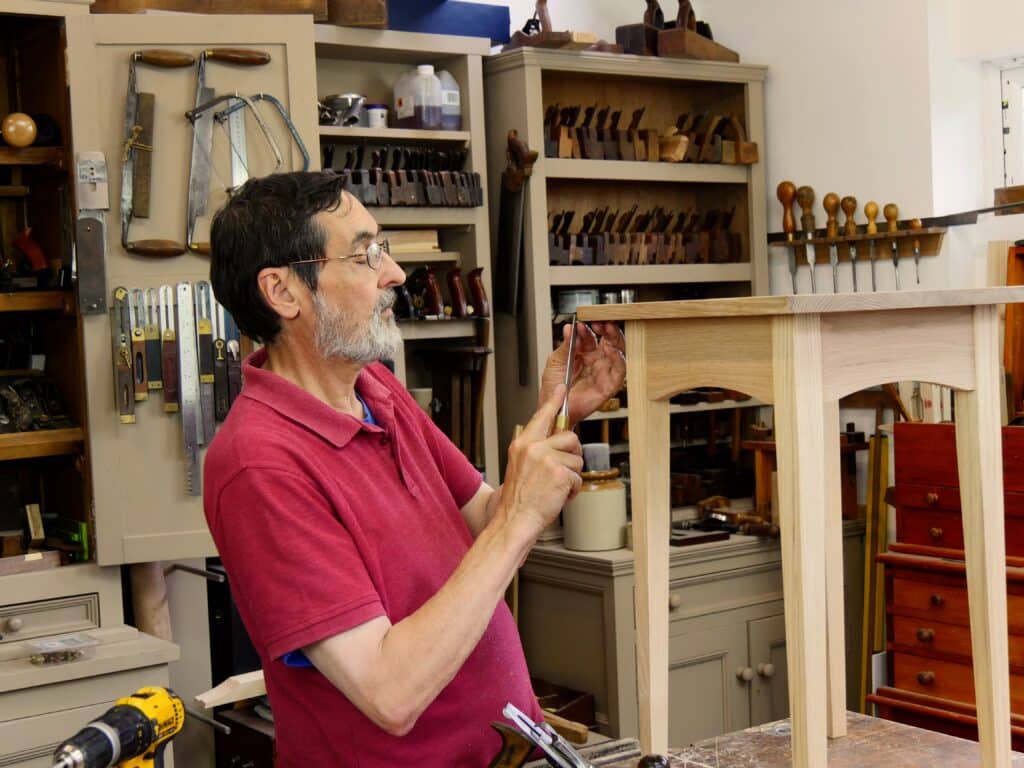
Throughout life as a full-timer, tools came my way from several sources. Retirees wanted to pass on their tools and so too their families. Who is going to walk past a plough plane in a garage sale for 50 pence or a whole tool chest in a garage sale for a few pounds? Then there are those offered by others out of kindness, knowing that you are a user and not an opportunist buying and selling on eBay. Wait long enough and you will have all of the tools you ever need for almost nothing, and especially is this so in England, living but 50 miles from the heart of where they were made in Sheffield for over three centuries. I have kept most of my accumulations of tools for many good reasons not the least of which is the reality that there is no shortage of them and I can give them away to those who might benefit most. I also have students on a more personal level who come in for extended periods or for apprenticing. One day, I am sure, they will be too much for those that follow to keep and they will go to auction or some such thing, but that is not likely as long as I am doing the work I do.
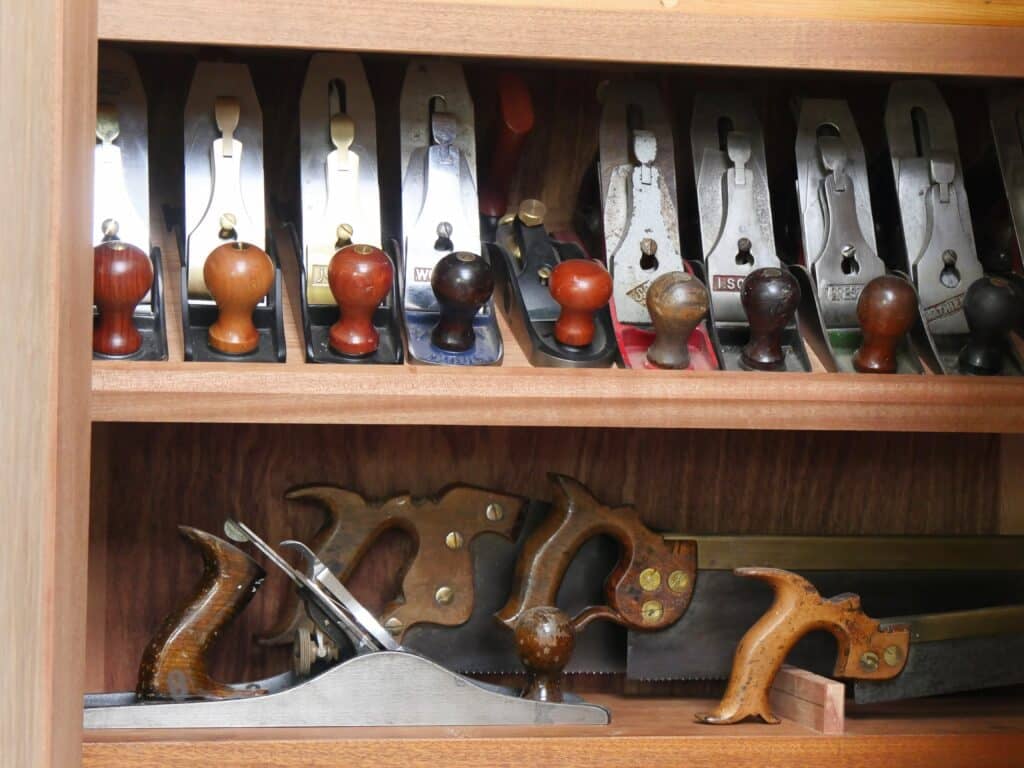
In answer to your question, I doubt that I would change very much if anything at all. If someone offered me a Lie Nielsen, Veritas, Quang Sheng, Luban, Wood River, Jumma or any other of the modern-day knock-offs of the Leonard Bailey-style Bed Rock bench plane designs, I would store it with the ones I already own and have bought for trialling and testing. My Stanley and Record versions are generally superior for a couple of exceptionally valid reasons. These, my personal planes, have been trialled now for 56 years in the day to day of life through 8-10 hour periods every single day, six days a week, and from the list of modern-day knock-offs above, I always reach for one of these two now vintage planes I bought new in the mid-1960s.
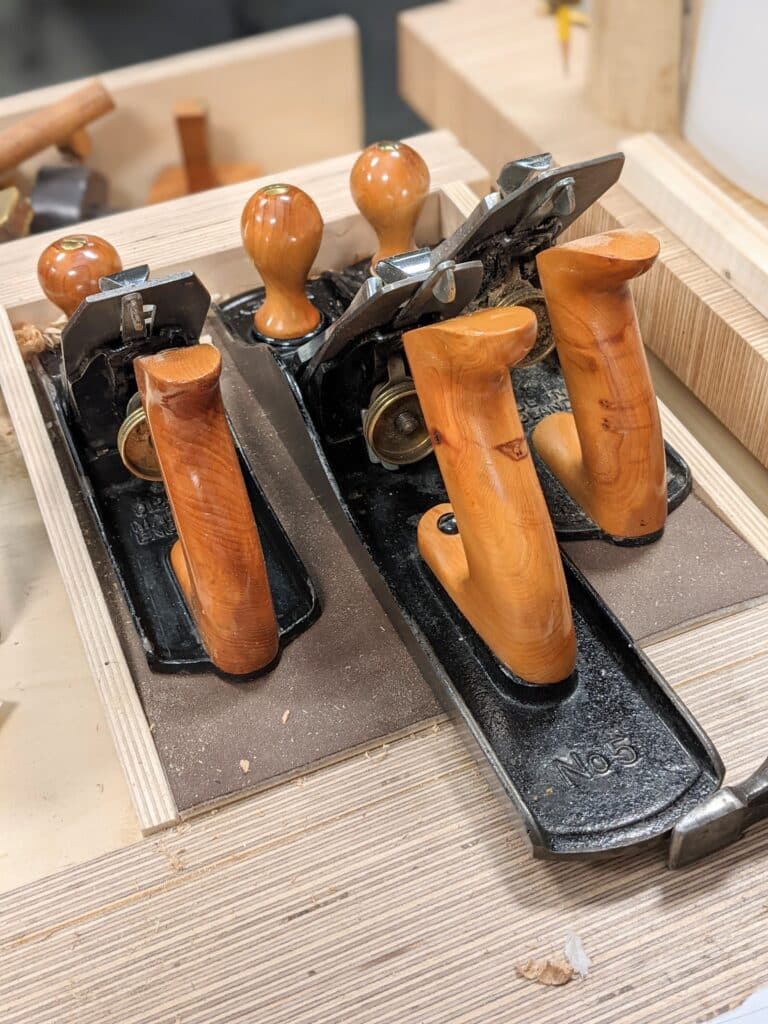
Why do I mention the length of time and days and hours? As it is with many things, picking a tool up at a woodworking show and testing it out at a woodworking show with all things pristinely set and tuned before the show and throughout the day is not the same as in daily use at the bench. Using different tools side by side as I do over extended periods now spanning years, we discover the subtle nuances that set one thing above any other. It is not just a mere preference but an earned acceptability that one tool has above any other. More directly, I would not change my current selection of benchtop bench planes, all Stanley models, for any of the modern maker brands because they do no more and much less.
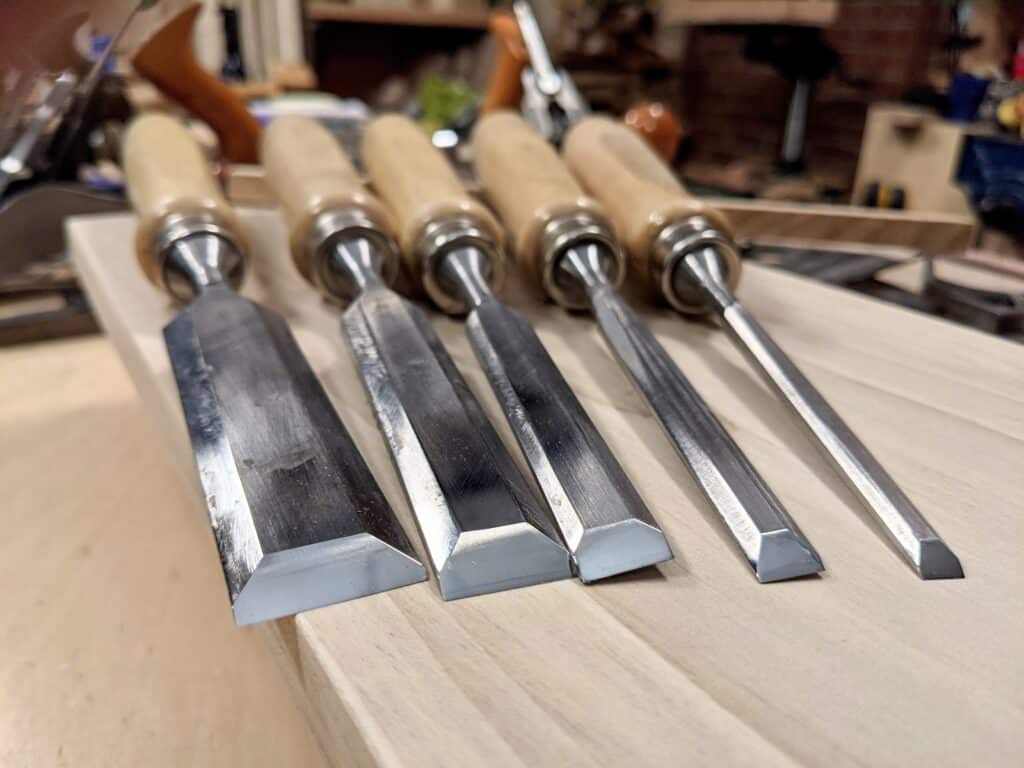
So there you have it. Heavier bodies and thicker irons, refined tolerances add little if anything to the qualities of how they work but some people just like heavy rigidity and hate tolerance and flex. I once read of how the Vikings mastered boat building in boats that ‘flexed’ along the hull so that they could ‘bend‘ with the tighter bends in rivers and in sea and river currents. The rigid counterparts made by other nations got stuck on a course and failed to negotiate. I feel the same way about overly rigid bench planes that offer zero flex. My Arabian geldings can twist and turn on a penny and negotiate every type of grain and awkward situation while still dealing with straight grain and developing a true and straight line as needed.
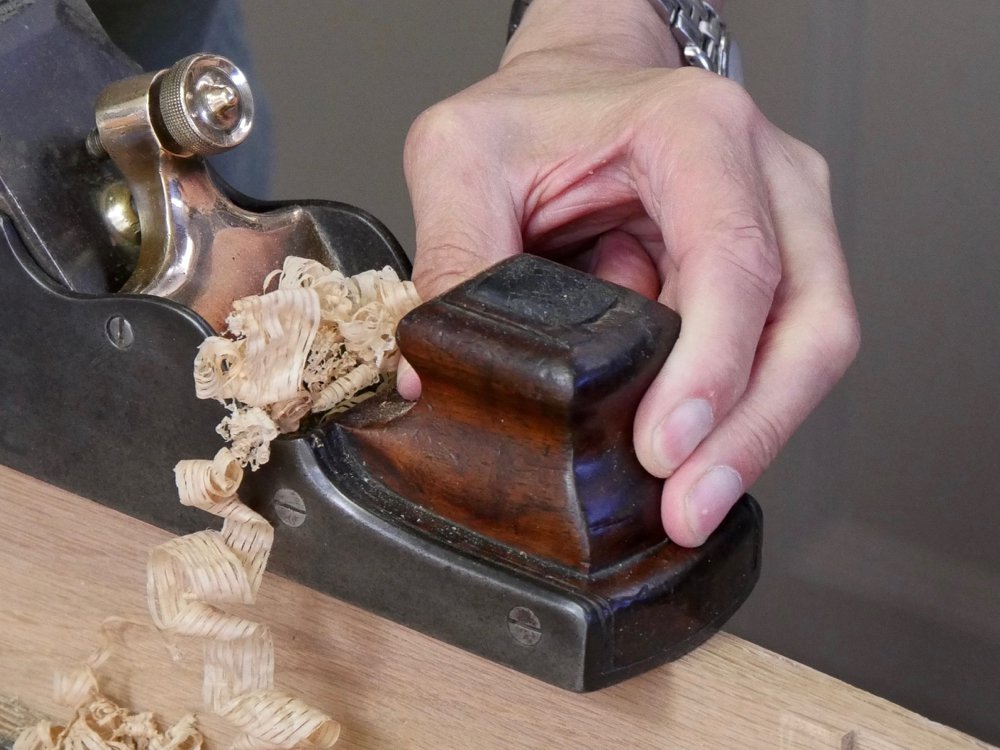
Notice the range of planes behind me in the top photo. I have some different types, a couple of Stanley router planes and the Preston types too of which I still own three. Which one do I reach for most? Here again, I own a few so-called premium ones too, the ones that don’t hang there. These are all good planes but the one I rely on most is the Stanley 71. It’s all I really need but the others are just friends. Why so many? I can set one to final depth and use that as the marking gauge too, and then I can use one of the others for altering the depth of cut as I go deeper. That way I can keep the one router plane set for skimming off the last surface to establish that finalised depth. It’s a luxury I feel no guilt about. There are enough on eBay every day to know that there are plenty to go around. When I started sharing my knowledge on the router plane they were selling in boxes for £10. Now that people following my work see their full scope and efficiency, they sell for upwards of £130. Do I feel bad about the high price? Not really, because they are so worth that price. That said, I have done something about the dilemma for those struggling to buy a good router plane. I have designed a router plane that functions every bit as well if not better and the adjustment stays dead on. A fractional turn forward or back is instant and the setting never moves through vibration. How about that? Cost? Well, you will make your own fully adjustable router plane for under £10. Make three and you will have what I described above, for under £30 and they will be heirloom quality. They’re built to last a lifetime.
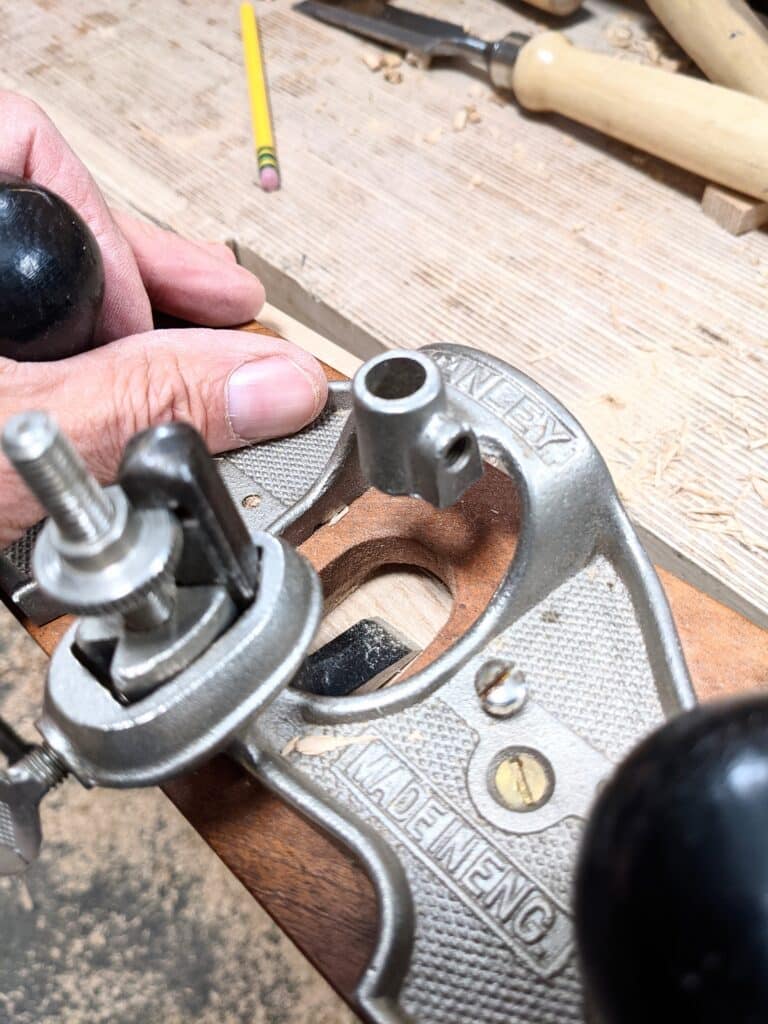
In one sense, I generally plumb for my three or four very ordinary bench planes because they are effective, lightweight, strong, durable and efficient. I do like a couple of low-angle bevel-up planes too, but not because they do more than these I just mentioned. Any will do, but my absolute favourite is the Veritas small smoothing plane. It’s the most balanced, well adjusted new-style plane I have ever used for a bevel-up blade. Its compact size makes it an effective plane that works in tandem with my bench planes. It is excellent for those of smaller stature but not too small for the largish too. In another sense, I do tend to work economically. I converted #78 to a heavy scrub plane followed by a #4 converted to a lighter scrub plane and these often preface my use of the regular #4, #5 and #5 1/2 planes. This is not minimalism but many claiming minimal are not actually makers like myself and never were. In my maker life, time is essential to being minimally profitable. Now don’t get me wrong, I can still easily do just about all of my surface planing work with a single #4 plane.
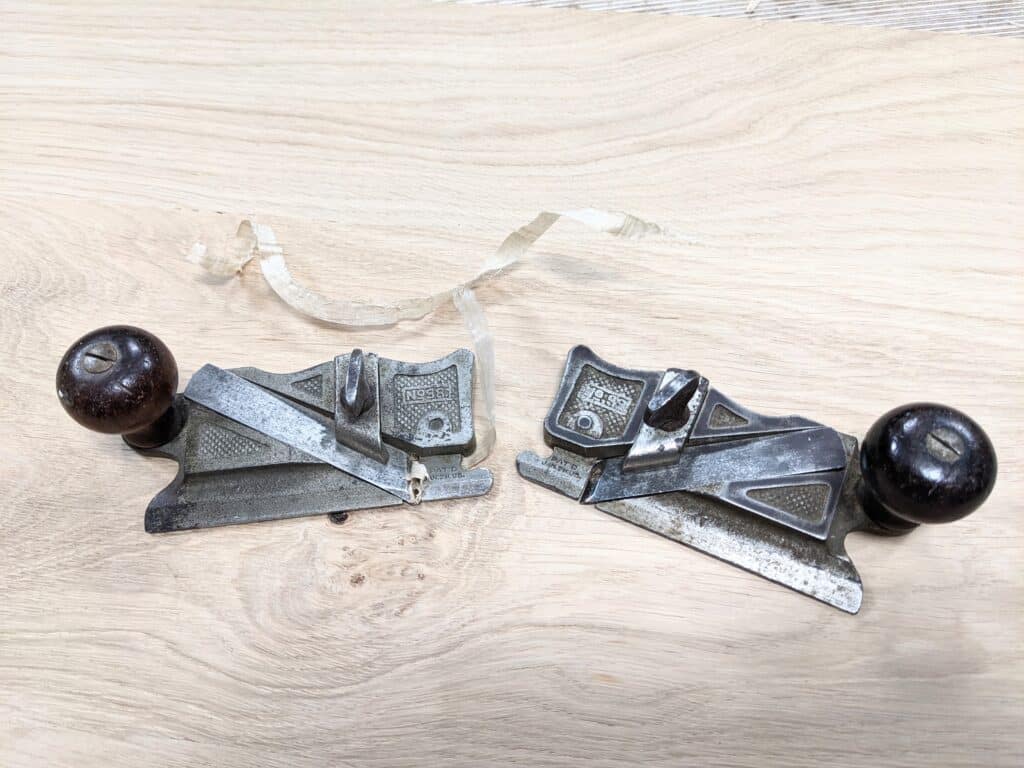
You may or may not have noticed the plethora of various tool types dotted around in the background or in the well of my workbench: marking gauges and spokeshaves other, less common and less obvious planes, a gathering of gouges and other chisels in sizes we use more scarcely but need from time to time, my 1/16″ and 1/8″ chisels, for instance. In my bench drawer, I have dozens of tools you see only once or twice in a video including mechanic’s tools like a socket set or adjustable wrench. We accumulate these for various reasons. I just dismantled my replacement vise because something was binding and causing me issues. I found the problem, fixed it with the wrenches and wished that I had done it three weeks before.
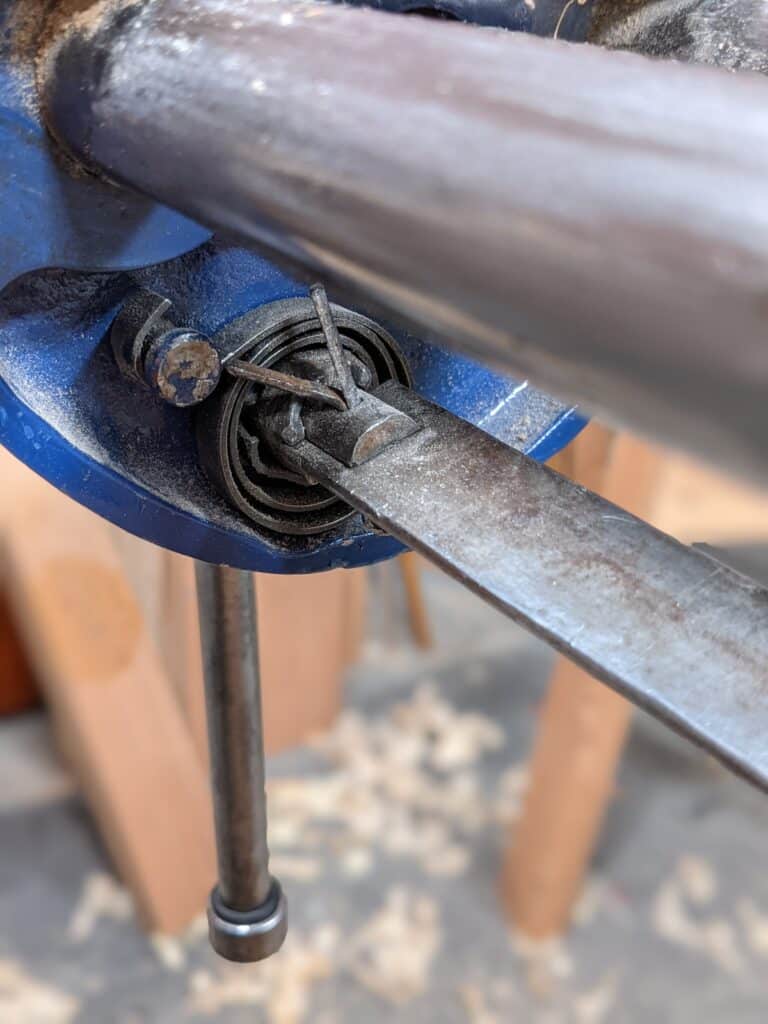
Combination gauges are amongst my favourite gauge types, two for the price of one, they can be had for around £10 secondhand on eBay — boxwood ones at that. eBay has generally become my best resource for buying all tools and especially secondhand ones. Here, I can work with individual sellers and then too businesses, all on a global scale. My Aldi chisels still suit me so well that I never went back to my more traditional styles even though they might at first seem slimmer, more refined and better made. These chisels, the Aldi versions, have been well proven for over a decade. I improved their quality by simply finessing the handles and the steel surfaces and so they are just as perfect as can be, they take and hold a good edge forever and they are the only long-term use versions that have never snapped or bent on me in a decade of use. Try pulling the handles off the tang and you will have a fight on your hands. This is no small thing when considering how much I use chisels in my day to day of woodworking compared to other users. That alone is a testimony above all others, I think. Whereas they were sold under the Aldi supermarket brand name, the makers are the German firm MHG. Dieter Schmid’s Fine Tools sells them very reasonably at between €10-15 per chisel or a set of six for under €70. Look for their ‘regular‘ bevel-edged chisels and don’t fall for the butt chisels.
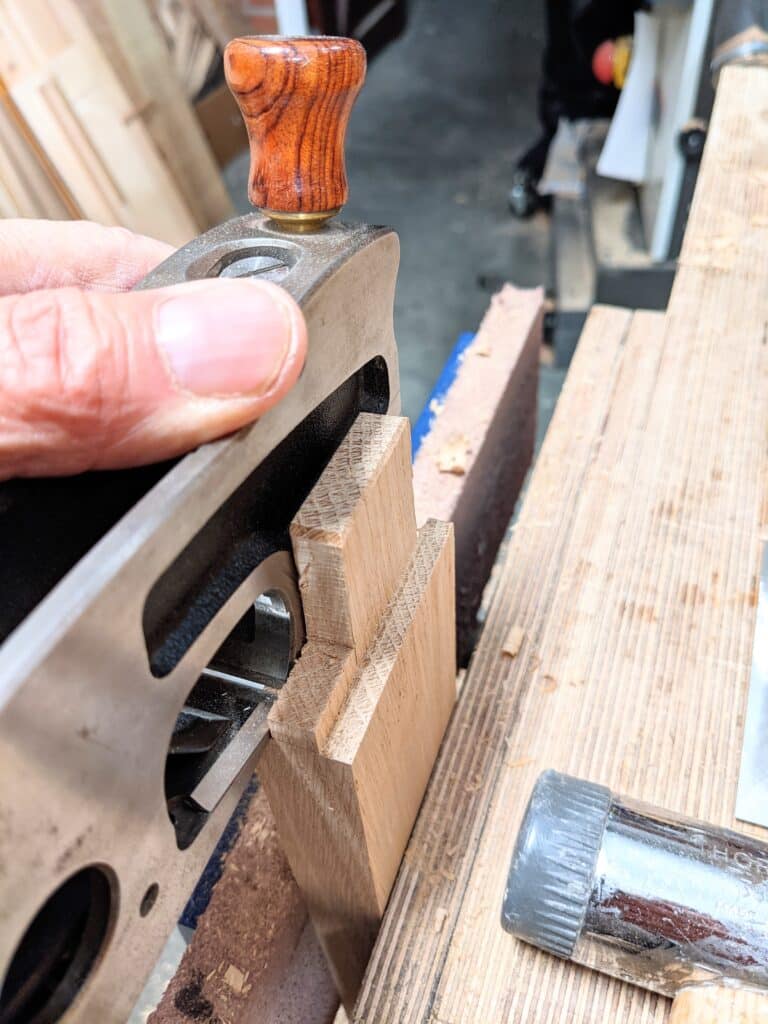
Other tools around and surrounding me are generally basic tools yet becoming more scarce. I frequently use side rebate planes by Stanley. These will get rarer as the years go by but I do find them ever useful for aspects of my work such as sizing grooves to precision when housing plywood into grooves because plywood is rarely a dead size of say half an inch but nearer 7/16″ but even then slightly less or more. The side rebate plane is a unique plane designed to trim off a few shavings to the walls of rebates and grooves too.
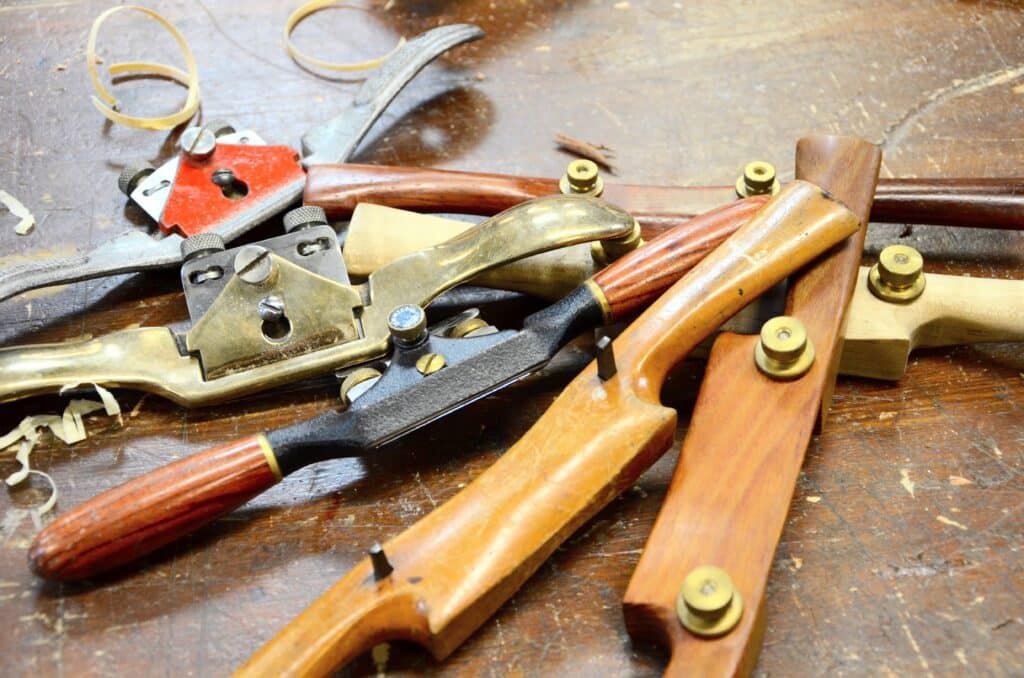
My spokeshaves are both very standard #151 style spokeshaves alongside vintage wooden ones and then those I have made. I have made a dozen or more different bevel-up spokeshaves where the blade is also the sole of the plane — a spokeshave is a plane but with side handles! Again, as with many tools, rarely is it a one-tool-fits-all tool. Bevel-up and bevel-down spokeshaves both have their place and I have several spokeshaves as a matter of preference rather than necessity. One of each would do for most people and even just a #151 we’ll do 95% of any work type requiring a spokeshave.
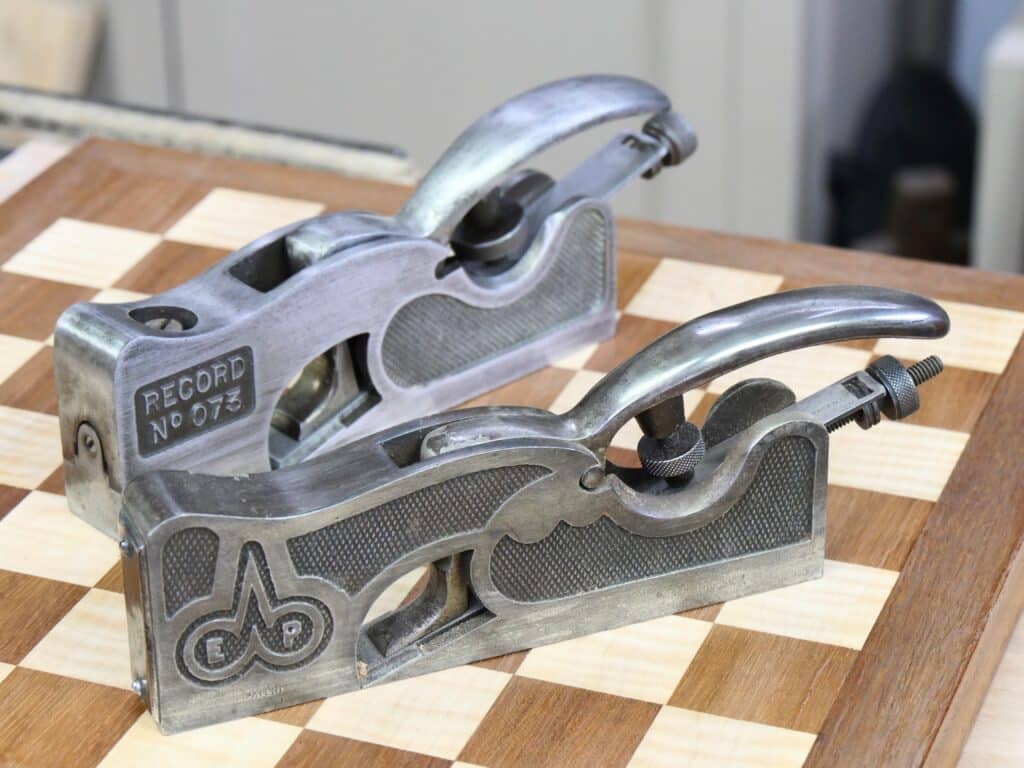
I have a shoulder plane that I like for the faces of tenons and then too the shoulders from time to time. Using the knifewall actually eliminated the need for shoulder planes. Transforming the term from marking knife to knifewall knife changed the game really. Once people adopted the knifewall line as an actual wall of severed and parted fibres along a distinct wall pristinely cut. This meant that a chisel cut would sever the walls to the exactness established by squared knifewall lines. Hence, the shoulder plane was rendered pretty much obsolete. That said, should a shoulder line be a fraction too long, a thou’ say, the shoulder plane will take that thou’ off in a single parallel swipe. More swipes will take off more according to need. On the face of tenons too, my system using the router plane for surface refinement of tenons using the outer faces of the wood as a registration face for the surfacing of tenon cheeks has rendered the shoulder plane obsolete once more. Why this was never done before I don’t know. Maybe somewhere in the annals of history, it could have been, but I never heard nor saw of it in all of my extensive research and certainly, it was never recorded until I made it popular. I was glad to be the originator that made it so relevant to our day and age.

Conclusion: The evolution of my workspace began as a burden for others to see exactly what it truly takes to work wood using real woodworking methods which in my view is in handwork predominantly. This is the development of skilled working to develop dexterity, skillfulness, strength and resilience of mind and body. Machine work will never give you any one of these, simply because machines were developed to replace them, substitute for them and remove the human input in industry to a minimum. One is soulless, the other soulful. It’s that simple. My workspace has been developed over a number of decades and never more than the last and most recent decade. Making hundreds of pieces ranging in size from miniature handles to king-size beds has been quite comfortable for me both physically and mentally in the 2.5-metre by 5-metre space. In many ways, less is more. It makes woodworking doable for all and is not in any way exclusive but totally inclusive. I could not assemble a full king-size bed inside the garage from which I work, but I can build just about anything I need with regards to furniture and joinery ready for final assembly elsewhere which is what we do with many large projects anyway. As far as I can see there is nothing I would change.


I love the explanation here. And what an awesome question. I’ve often wondered about the preference of Paul myself. I like that most of the training/videos has been tailored to try and reflect what most of the people who are watching have access to. Most of us work out of our garage on a part-time basis and don’t have the luxury of buying a plethora of tools. Second-hand tools have been my savior in that I’ve managed to snag many of the tools required to complete most of the projects that I’ve followed along with Paul on. Well written as always.
Thanks Paul. I have a mixture of eBay vintage tools and premium ones. I find that both produce the same level of quality in the wood. The tools that I like are the ones that I actually use day to day and has nothing to do with how much I paid for them. For example, about three or four years ago I picked up a vintage Craftsman brand no 4 handplane that looked to be unused and cost $25. I use it the most as I hog off most of the waste wood then go to another hand plane for the final few passes with the sharper blade. If I could only have one hand plane it would be my Craftsman No 4. It works as well as my LieNielsen handplane and I like my Craftsman better mostly because I use it more frequently and it feels like an old friend in my hand.
I just googled my distance from Sheffield: 2643 km (Tirana, Albania). I’ve never had the chance to see a router plane, Stanley or other, let alone buy one. But I have made Paul’s router: https://paulsellers.com/2012/03/not-so-poor-mans-router-really-works/
I am using it from more than two years now and it is awsome! In a video somewhere Paul says that one can lift the back of the spokeshave to take a thinner shaving. From that I started lifting the back of my router, to take a shallower cut when doing housing dados (I have slightly rounded the front edge of the router to ease the ride). So I go free hand with the chisel “shooting for the stars”, then with my router for the final depth. It’s easy, quick, accurate and it costs nothing.
If you like that one then I know you will love my new version of the router plane out soon, Ermir. Adjustment is the simplest, dead accurate and versatile.
can’t wait to see it!
This is great news! I can’t wait to make it and use it. It will be my P.S.Router v.2.0.
…router plane prices will start dropping, I guess 😊
Thanks again for everything you teach us! Your work is so valuable!
Paul, one of the reasons I watch your channel is because I am very impressed with the awesome work you do with minimal tools.
I went backwards and collected a lot of vintage tools off ebay first. Now after learning from you most will wind up on the wall being “comfort” decor.
I have learned a lot from Master Classes…and I do appreciate your knowledge and sharing. Getting into this pastime (I am retired) is something I will never regret. Thank you so much for sharing your skill and knowledge!
Just my personal preference as a daily viewer of your work, but I much prefer the old workshop, with the natural light and general atmosphere of a more traditional woodworking space.
I relish reading these posts. After a serious operation and going thru a six to 8 week recovery time shows to me how much i depended on being in my small workshop. Just being there building ideas or seeing where i didn’t use enough patience while doibg a project. Seeing where i could improve my sharpening skills are what i consider the most important. I look forward to reading what others enjoy in woodworking. Thank’s
The tools I like the best are the ones I have tailored or fettled to fit my hands.
I have a brass backed tenon saw , I shaped the handle and sharpened it myself. It gives me great pleasure just to hold it. I have a Miller’s Falls block plane given to me by my father when I was 10. They are still inexpensive but I would never part with it. Again it’s something I learned to sharpen and it works better than my lie Nielsen with it’s thick blade of hardened steel. it fits my hand, it’s lighter and easier to sharpen the blade.
My father also gave me a Miller’s Falls block plane about 50 years ago. It is still in use. It is not just old and treasured, but feels good in the hand and the blade is rapidly sharpened and adjusted. It’s good, through the magic of this site, to know others feel as I do, about the good old tools.
Hello Paul.
Thanks for responding to my query so thoroughly. I do appreciate it.
It’s pretty cool that what may have started out as a way to make this craft more accessible to more people has resulted in you distilling your toolset to this core group.
Every time I see a video or post elsewhere that claims I have to have this or that amazing (usually expensive) hand tool, I remember that I’ve seen you do the same task with little more than your Aldi chisels and number 4 plane. It stops me from overspending on tools that may just clutter up my shop.
I really enjoy your style of instruction and I wait your updated router design with bated breath.
Hi Paul,
I’m looking forward to seeing the new version of your router plane. I made my own adjustable one a couple years back which I use regularly. I’ll be interested to see how it compares.
Did you do your usual tuning also to the small veritas smoothing plane Paul? I.e. rounding with a file etc. Best Christian
I did. Those hard corners, even when mildly beveled by makers, don’t really work too well to stop corner-grab grabbing.
Thanks Paul! Your post tempted me to ordering one 😉 (at dictum they say should come in 2 weeks). suspect kids will also love it given that it is smaller… thanks Christian
I’ve put myself on a tool diet! I’m not buying another tool until I master the 3 joints! I also really like building my own tools, it just seems right especially for someone like me that doesn’t use them too much. Besides for whatever reason using a tool you made gives you a feeling of independence over the task at hand.
Hello Paul
Just like to pick up on point in this blog post about old and new tools.
You say:
“In answer to your question, I doubt that I would change very much if anything at all. If someone offered me a Lie Nielsen, Veritas, Quang Sheng, Luban, Wood River, Jumma or any other of the modern-day knock offs of the Leonard Bailey-style Bed Rock bench plane designs, I would store it with the ones I already own and have bought for trialling and testing. My Stanley and Record versions are generally superior for a couple of exceptionally valid reasons. These, my personal planes, have been trialled now for 56 years in the day to day of life through 8-10 hours periods every single day, six days a week, and from the list of modern-day knock-offs above, I always reach for one of these two now vintage planes I bought new in the mid 1960’s.”
How can you know these modern tools of which you speak are inferior for the reasons you point out ?
To say that you prefer your old Stanley planes etc over the newer models simply because they have served you well over 50 years does say something about their longevity, but that’s not the same as saying they are superior to modern tools of the same class.
To say with any confidence that “the old is better than the new” surely they both must be used over the same extended period, only then can one make a comparison in terms of better or superior.
To say that you “prefer” old over new is one thing but to say that one is superior to the other is without foundation in the manner in which you claim superiority for the old.
I am not without cognisance of your experience, but it seems to me that you have a very distinct bias toward older tools, and that’s fine so long as it is acknowledged as bias and your preference of one over another in this instance is without foundation, at least in the terms in which it is couched in this post.
Kind regards
Gerry
It’s your assumptions that might be a little flawed or skewed, Gerry. The superiority is in the lighter weight of Stanley and Record. Thankfully! You can never make a far-too-heavy plane lighter yet lighter is, in my view, and after using the lighter weight planes for 56 years, vastly superior to these shire-horse (Clydesdales) versions. These other planes wear my arms out in half the time. Probably they are okay for an hour’s work a week, but I use them throughout my ten-hour days six days a week. Have pity on me! And then there is the looser threads on the Stanley and Record versions too. The adjustment wheel spins to uptake in a split second with the flick of just an index finger in both clockwise and counterclockwise. I could go on. Oh, and it has nothing to do with any biases in favour of old over new, as you wrongly surmise. Many of these modern makers are not making the superior Bailey-pattern plane with its superior frog but only Bedrock-type frogs. Adjust the Bedrock frog with its sliding bed and you actually reduce or increase the depth of set and thereby the depth of cut. No one but no one mentions this. Not a good plan. Not a good plan at all!!!
If I can, I’d like to add my piece of cake. If you propose a new concept to an “experienced” man, there is a high chance said man will resist/refuse it. I the Army we use to say that there is one only thing harder to do than introducing a new concept into a veteran’s mind and that is removing the old one. That being said, I recognise also that after working with tools for a long time one can make it with a glance if a “new” tool is worth/comparable with the value and performances of the old ones or if it’s only a new market toy. Wisdom inevitably comes with experience. It’s not something you can buy on eBay, unfortunately. When I want to make a wise, well informed decision on something to buy or any other important courses of action, the first thing I do it’s asking a person I know has the specific knowledge/experience. If I can’t afford that luxury then I ask google and look for sufficient opinions of people with experience in the field. Then I question myself and make my own informed decision. Not always it works completely well. But in the end wisdom also comes from errors… some say that a wise man, in a specific field, is the one who already made all the errors in that field….
I think there might be a difference in opinion on the internet about weight vs. nimbleness depending on how the user uses their planes.
Paul and anyone who might use hand tools almost exclusively may benefit from lighter planes because of the fact that it may take quite a while to flatten boards for a cabinet project and other larger projects.
Someone who uses power tools for all the prep work and even some of the finer work might only use a plane for final smoothing, in which case a heavier plane may not be too much of a hindrance. I know Rob Cosman, for example, likes new heavy planes, but he uses power tools for most of the grunt work, and only uses hand tools for the finer joinery.
I think it comes down to how many hours a day you spend with a plane in your hands. If it’s only an hour or so here and there, weight may be less of an issue and maybe a heavier plane may suit your tastes. If you spend the whole day with hand tools, then lighter and equally effective tools may suit you better.
In my experience, I prefer wooden planes. Why? They’re lighter, have lower friction in use and are kinda cool. They do suffer from a lack of easy adjustability, but I don’t work wood for a living – I do it for fun, so I can waste a little time adjusting them with a hammer. I still have my Stanley metal planes, and use them occasionally. I even have a few Bedrock-style planes, and find them okay. Nothing special, but not bad either. However, unlike Paul, I don’t spend hours of my day planing. 🙂
And I don’t spend hours of my day planing either but I do spend a percentage of my time — big difference, depending on what agenda you are on and how you want to express it. I hope you can see this difference because it is important when you say things like, “Unlike Paul, I don’t spend hours of my day planing.” This is erroneous and sends the wrong message altogether. It conveys a tedium and a very different picture to the reality of my day, I’m afraid. So I say, well, neither does Paul! A drawer side I just made from 1″ thick stock reduced in thickness to 1/2″ on the bandsaw, 21″ long and 7″ wide took me five minutes to true up, rip to thickness and finish out with a scrub plane followed by a #4 smoothing plane; this was not a dense-grained wood but poplar, admittedly. The joint took me 30 minutes including filming and talking, so planing was but one-seventh of my time. Magnify this by hours in a day and I spent roughly an hour or so doing the planing bit. How do I know this? From the length of the video I recorded.
It is indeed very easy to put others off by suggesting that they will have to spend hours of their precious time planing and sawing wood. I strive to give my very best shot to my audience which comprises new woodworkers and seasoned machine-only woodworkers searching for answers. My experience of woodworkers in the USA, for instance, compared to the UK and Europe, is that a large percentage of US woodworkers do indeed already have a full machine setup and the space to do that. Over the 23 years of living there, I impacted them by showing how efficient handwork can be. I never told anyone to get rid of machines. The ‘converted‘ had always been wannabe’s but never quite made it until I showed them how. For me, a 71-year-old diabetic still thriving in excellent control and health, the planing is critical to both my physical health and wellbeing. 95% of my daily exercise comes from the way I choose to do my work. This will be the same for many if not all with a degenerative disease, disability or whatever. To make it clear, good exercise such as planing and sawing wood by hand beats machine methods a thousand to one whether you need to exercise or not. Handwork enables me and others in other ways too; I also work with Autists who use my workshop and who I mentor in the day to day of woodworking. If I had a machine shop they would be out of the door for different reasons surrounding their disability. My hand tool shop creates and nurtures others in a safe and secure place.
My apologies, Paul. I should not have said that, especially since I don’t know what your typical day is like. What I meant is that you use your hand tools all through the day….of course, only a (small) part of that time is spent planing.
My intention was to separate the work of people who use hand tools as a supplement to their power tool work from people who work almost entirely with hand tools.
For the former, a little extra weight in a tool is not likely an issue as there is less cumulative effect through the day. For the latter, a little extra weight in a tool may result in fatigue before the day ends.
I subscribe to probably 20 woodworking channels. Some hand tool, some machine, some hybrid, some restoration, some handyman; there is always good ideas and inspiration to be gained from everyone.
I used to subscribe to Rob, he is a very talented woodworker; however, I unsubscribed.
Rob has at least 2 full machine shops and a plethora machines in each. He also has his own tool manufacturing business. I do admire and respect him for his support for Veterans.
Why I unsubscribed?
A couple of reasons.
Mainly arrogance.
A year or so ago he had never used masking tape to hold edge beading to a board till the glue dried, that’s how I was taught back in 1978 as apprentice. He rubbished the idea and tried to disprove it on YouTube, he was proven wrong.
Pay close attention to his tool reviews, every tool he reviews rates second best to those he helped design, market or has sold.
Even exact same tools from the exact same maker under a different name rate poorly. It encourages people to be tool snobs and outside of the US and Canada the tools he brandishes are cost prohibitive. People see the results of a highly skilled craftsman like Rob with over 40 years refining his skills, think they can replicate that, rush out and buy the premium tools he is reviewing only to be dissatisfied with their results. They get disgruntled, lose interest resulting in wasting their money.
Sure, nice shiny premium tools look great on a tool wall, but they don’t make the craftsman.
It’s all well and good to tell people they come ready to use straight out of the box with only a minimum of refinement; sooner or later the user is going to have to learn how to set up their tools, that’s part of the skill.
You can’t afford to run out and buy a new tool every very time it goes out of calibration.
Whereas I find Paul helps people start out by using what is relatively cheaply available on eBay etc. set them up and as their skills develop they can invest in higher end tools if they choose.
They see high end work done with old second hand tools.
This is smart business.
P.s. I suspect we’ve only seen a small percentage of Paul’s tools on display, we did see large packing cases of tools during his move video, and to have enough tool to need to archive them is telling.
I too used to watch Rob C very closely until one day I ended up watching one of his Q&A live shows. I noticed how he would not answer as to why he would not give a comparison between two basically same planes. He made some little comment about lawyers being involved. I had my lawyer brother look this up. And yest he got into a hugely financial mess over a contract he had signed with one of those two plane builders.
But I degress. During the show there were other little snide comments made regarding products made by other than him. I sent in a question that explained my thought that his shows were in all but name Infomercials for his products. He took shots at Stumpy Nubs using past wax and Paul using oil to make their tools slide easier, he flat stated only his wax disguised as a full-on deodorant was any good. That was the last I’ve watched his shows.
The wax he can never find. Lol.
My favorite hand plan is my Stanley #6. I know it’s a monster, but it was the first hadn’t to I bought. It’s the one I learned to sharpen and tune on. And I recently made a new tote for it. I can’t expand it but I can take a cleaner more even cut with that plane than any other that I own.
Hi Paul,
I’ve been thinking about this post for the last day or so. What might make a fun video would be for you to go through your original tools that you purchased when you had finished your apprenticeship. You had resource constraints and since this was your livelyhood you needed tools that worked. Obviously you’ve written much and this is essentially covered. Still, I think many would like to see it. Not so much as an endorsement for what to get now. your common woodworking site does an excellent job at covering that. Just a thought for your consideration.
Sincerely,
Joe
Paul always says: “work with sensitivity”.
I have learned a lot about techniques with the videos but, “working with sensitivity” is maybe the most important (and difficult?) thing to learn.
In my view:
– it is easier to do with a light tool because you don’t have to overcome the tool inertia to put it in movement.
– on the other side, once in movement, the heavy tool will continue even if the blade is not very sharp. Is it why some people like them?
On a related subject:
There is a nice Paul Sellers video where no pressure is applied on the plane as it is towed with a rope
Using the “oil rag in a can” on the plane sole makes the plane feel quite differently. It is easier to feel the dullness, otherwise one feels the friction of the sole on the wood.
Love the expression “towed with a rope” 🙂
Yes. Should it be toted with a rope???
I don’t believe English is Sylvain’s native language. I understood what he meant. Be nice,please.What makes this site so wonderful is it’s international appeal.
Nothing remotely unfriendly from me, I was joking; as in the plane handle is a tote, so toted which is not an acceptable word really. Sylvain’s “towed” was just fine and totally acceptable. And Sylvain is a friend. I was perfectly friendly.
My native language is French and…I made my (at that time mandatory) military service in the (Belgian) Navy.
Hi Bob,
Please note this is not a trolling thread and both you and Paul are coming from a place of kindness (albeit a cheeky one 😋).
In reassurance to both I’d like to add: though passionate about languages, and ‘living in English’ for nearly a decade now, I’ve thought myself this language so it remains a patchwork of gaps and flaws …however, after watching many of Paul’s videos where he used a ‘brace & bit’ and commented “this is so boring *cheeky smile*” one day I finally ‘got it’ while using mine 😆
I was alone with myself, surrounded by my friends (tools and bits of wood) in my tiny workshop, but I tipped my imaginary hat to imaginary Paul overseeing me from the corner with a wink
These little things are a delight for us ‘non-native speakers’, to me – THAT is fantastic for my mental well-being.
Keep it up Paul, I ‘totes’ love it!
I could have used “pulled by a rope” but in fact “towed” is precisely the image I have.
A boat cuts through the waves and the plane slices the waviness of the board. It doesn’t slide like a sled for which the resistance to movement is only friction.
My biggest workshop grow happened when I finaly build proper workbench. After some dreaming about machine woodshop I start searching for machines and so, but I couldn afford them both for their cost and their size. So I digged moře and after Steve Ramsey’s videos I found Rex Krueger and finally You, master Seller. Then it clicked…
I gather some wood (relicts of house build and so on), buy one Ryoba, sharpen two benchplanes (wooden scrub plane and stanleys no.4) and some chisels and made naše fór Moravian workbench by my hands. Planning and gluing the top was done by friend of mine with his machines-I have had no hope for good result on 2 meters long pieces on sestup I had. Now I can do pretty much anything in small part of a garage with my little handtool collection.
Thanks for opening my mind. I cant thank You enough!
Some autocorrect typos (phone try spell it in my native language):
*So I digged MORE and…
*…and some chisels and made BASE FOR Moravian workbench…
*…2 meters long pieces on SETUP I had…
Greetings from Moravia, part of Czech republic 😉
Sounds awesome. Right in Paul’s style
I bought about $500 worth of tools to start my new job and I stressed out cos there’s so much junk available and if I bought rubbish I would feel tied to it: or at least a dummy. A friend who was in the trade gave his recommendations and some tools I already had preferences from experience.
It makes a real difference to have a selection of tools that meet form, function and cost. They are always in fashion without brought colours and brands.
Hi Paul,
Reading through this post made me think of our woodwork teacher in our Secondary School (sadly it seems practical skills are rarely taught any more) as first year students Mr Cordez went through the very basics to start with, naming all the tools and their uses. He then proceeded to show us some simple joints using the tools on the chosen bench he was standing by, he then moved us all to another bench and produced a different joint, after 2/3 different moves around the classroom he asked us why we thought we had moved from one bench to another using the tools on bench where he decided to make whatever joint he was showing us, no one gave the right answer to his question so he told us, “there is nothing magical about the tools he used on the first bench, the second or third, they’re all the same, not inferior to any of the other tools on all the other benches, the only difference is our desire to turn out a finished product and the only way that would happen would be if we knuckled down and practised and learnt the correct skills and became familiar with each tool and how to keep them sharp.
Some things in life you never forget and that was one life lesson that has served me well during my career as a Carpenter.
Paul
I would like to have met a Mr Cordez in my youth 🙂 thank you for sharing your (hi)story Paul
Thanks for the lovely post.
From what I understand, Aldi “Workzone” chisels say “Made in China” on the package, while MHG chisels (according to Dieter Schmid) are made in Thuringen, Germany. They look similar, with minor differences in handle shaping and finish, but I do not think they are made by MHG.
You have clearly proven the Aldi chisel to be a very capable contender, and the rock bottom price makes them affordable to everyone, but shouldn’t we know more about the company that is making them and (hopefully) how they treat their workers before jumping on the bandwagon?
I am not stating that everyone should purchase expensive Lie Nielsen chisels because we know that his employees work under good conditions and make fair wages, but shouldn’t we look for that from any chisels maker? I already thought Narex chisels were inexpensive, but a set of chisels for £7 makes me worry for the worker.
Cheers, -Scott
That would be helpful, Scot. If you have the time I think it would be interersting to know.
The Aldi chisels certainly used to be made in Germany and my Lidl’s version were too.
Hi Paul,
I gave up on ever finding a set of Aldi chisels about three or four years ago and bought a set of Harbor Freight Chrome Vanadium Chisels just to have for rough work. They sat not used in their bubble pack until I finally bought my first set of diamond sharpening plates a couple of months ago ( I am very slow in adopting new work methods). The chisels made a good first use test for the plates. The plates were amazing, should have taken your advise on the plates years ago.
The chisels impressed me to the point that after a few test they ended up on the wall rack behind my bench for further testing and possibly new handles later on. They actually performed better that some “premium chisels” I purchased thirty years ago. I saw these chisels mentioned a few years back in a blog (maybe yours) I do not remember, based on my experience they are a diamond in the rough.
Dear Paul
I have tried to follow your directions to “the German firm MHG. Dieter Schmid’s Fine Tools sells them very reasonably at between €10-15 per chisel or a set of six for under €70. Look for their ‘regular‘ bevel-edged chisels” to no avail! I have already aquired a set of the ALDI chisels but would like to get at least one more set so that I could alternate their use while working on a project. Is there any chance that you could post a link to your specified option? I am not able to find it on their site -my digital illiteracy is at fault, no doubt!!
I remain, yours faithfully
Fiachra
https://www.fine-tools.com
/stemmeisen.html
Fiachra, if you scroll half way down you’ll see them
Hello Fiachra, I found my MHG chisels here: https://www.fine-tools.com/stemmeisen.html
The “regular” chisels are there, a long list of sizes.
Regards from Tore, Norway
Try a set of Three Cherries. They appear to be very good and at an affordable price.
No they are not Chinese made. They are English made.
Pretty sure these are the Aldi ones.
https://www.amazon.co.uk/dp/B00CFY1WI8/
Perhaps someone can check against ones bought from Aldi.
Shame that they are calling them “firmer” when they are bevel edge. but they look the same as my ALDI ones.
Going back in historical terms, it’s actually correct to use the term firmer and firmer bevel-edged chisels with ‘firmer‘ and ‘bevel-edged together. Mostly these days we just use bevel-edged chisel.
Thanks Paul. I had always thought of firmer as rectangular in section. I did a quick scan of the internet brings up different definitions and different descriptions from different manufactures. I guess that it is more fluid than the types in my head.
Well, I think it would have been easier to have the rectangular profile for firmer and then the ones with bevelled edges as bevel-edged. I realise that this makes sense, but it is also important not to lose the historical terminology along with the transitional changes whereby the majority of chisels were square-edged at one time instead of as they are now, predominantly bevel-edged. I doubt that we will see too many square-edged firmer chisels being produced long term as they are less versatile and they are more awkward to use. It is interesting to see how many chisel types there were at one time though — registered, mortise, framing, slick, cranked neck, paring, sash mortise, corner, skew, socket, dovetail etc.
Fiacra-
I believe the “Regular” MHG chisels Paul is referring to are half way down the following page. YOu have to scroll down a ways:
https://www.fine-tools.com/stemmeisen.html
https://www.fine-tools.com/stemmeisen.html
Scroll down for regular chisels!
I do like my ALDI chisels – nearly bought 2 sets, regret not doing so. But I already have many old ones.
I too took to gently used tools as a way to afford my gentle hobby. I being retired when I started this journey did not leave much free cash. I quickly realized watching Paul that I didn’t need the fancy new tools out there. I have found that these older tools. Some well over a century old have much to teach me.
I am however not a handtool purist. I use power tools to take on the mindless tasks that are to physical for me to perform. But even these are used. An example is the 4100 Bosch TS I bought a few months ago. Paid $100 for it and the Easylift base. I put another $75 in it and I can make cuts as well on it than I could on a Saw Stop that I tested at a show. Sure it took a little work. The same goes for my Ebay chisels and other tools. But that is part of the overall experience that I so much love.
PS: I built my little 3.5M × 5M shop in my backyard. My wife and myself did all the work.
“Many of these modern makers are not making the superior Bailey-pattern plane with its superior frog but only Bedrock-type frogs. Adjust the Bedrock frog with its sliding bed and you actually reduce or increase the depth of set and thereby the depth of cut. No one but no one mentions this. ”
I have to laugh at this.
Removing the cap iron to sharpen invariably results in slight differences on reassembly. No one but no one mentions this. Happens on Bailey’s too! Seems like a bigger problem than the infrequent adjustment of Bedrock frogs.
YES!!! Can’t wait to see it Paul. I’ve long since had a feeling in my bones you would do a router plane build. Not to discredit your poor man’s version, I’m sure many are deployed in daily use in workshops around the globe thanks to you. I often look at videos of people’s DIY router plane builds and think….Mr Sellers will come up with one of these soon! My prayers are answered. I would love a Stanley router plane but don’t have the funds presently….but a Mr Sellers router plane for a tenner!!…Yes please.
Many, many thanks for all you and your team do Paul.
Hi Paul, thanks again for putting such comprehensive text (with strategic photos) on ‘everyone’s favourite topic: quality hand tools’.
As I unpick the text with so many points and maxims… most of which I can only understand in my superficial mind, but I’ll try to retain it there ‘til the day I can feel it, and ‘get’ what you meant, one sentence stood up to me and warmed my heart:
“Wait long enough and you will have all of the tools you ever need…”
Indeed.
I’m by far more passionate than skilled at woodworking, “lucky me” (not really) that bar isn’t very high in my space since I only know a couple of people interested in working wood, and if these I am yet to ‘convert’ one to doing it manually…
But, I do love it, practice it, and talk about it. Then, my lovely neighbour* donated me pretty much a full tool box of quality Stanley & Co
* my extremely active 87 yo neighbour who’s far too busy on his conservation efforts to work wood – he plants it 😉
My toolbox is almost complete, and you’re onto it: looks like if I keep on working wood, and being nice to others, the tools just materialise somehow – quite a phenomena.
Paul, I have enjoyed the run down on tools in your shop. I also can appreciate your shop size as mine is 10′ X 16′. I plan on adding more space but will probably move my power tools into it and keep the smaller original space as my hand tool sanctuary. Keep up the great work and I do have one question. I often see you look up toward your left and give a slightest grin, who is on the other side of that look?
It’s most likely Joseph, my son who works with me.
Thank you, I knew their was something special over there.
Dear MR. Sellers, Have I bittern off more than I can chew? I am 78+, I spent most of my working life in the motor industry, highly mechanised, timed down to the nearest hundredth of a minute and relentless.
I have had short periods of woodworking but, and here is the problem, I have acquired quite a lot of powered tools(one thing that I am proud of is the router table I made from beech and rock solid).
Then I started to read, and taking in your blog, I looked about my workshop and discovered that I had most of what I needed to make a go of making by intuition what I had planned for my future projects IE the architrave around the openings in our extension. Well no I had not, no moulding plane for a start, no stick board? and no idea of how to obtain either(plus no idea of how to go about it if I could obtain them) Am I nuts to try or is there hope for the old dog yet.
I have been cursed by being able to learn by watching someone do stuff and hit the ground running so no one spent much time with me (the clever ones played the old soldier)but I can ,and will, get this one under my belt. ANY help will be most welcome.
dear Paul, I’m not certain if this is the appropriate place to ask this, but as a side to taking your advice on many aspects, I recently bought a used dovetail saw. The teeth were in terrible condition, so after watching one of your pertinent videos, decided to re-shape the teeth. The metal filed ok, and I was cruising, then thried to cut the slits to start new teeth, and oops… the hacksaw will not cut the metal, which claims to be cast steel (W Tyzack & Sons & Turner) Elephant brand. The only brochure I can find that lists it is from 1921, so I am reluctant to give up or bodge it. Do you have any suggestions please?
Some saw plates are indeed extremely hard and I have had them where they could not be sharpened with a file either in part or the whole. I have avoided reheating the steel to take the hardness out because it would most like cause a warpage and uneven hardness ad tension too.
If the gentleman was doing well with a file why can’t he continue to do so and may even replace the hacksaw with a maller file like a die makers small file when starting new teeth?
I got the impression the file wasn’t working too well either. I have had a couple of saws where the file could not make a mark on the teeth no matter what. One was a vintage Disston. I could be wrong, but if the teeth were too hard for the file it would be a problem. He can use anything he wants. I don’t mind.
Thanks, I will try some different saw blades, and if that fails, replace the saw with a new file.
It might be the quality of the hacksaw blade? You also need one with as large a TPI as possible. Not all hacksaw blade are of the same quality.